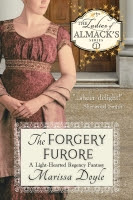As I have in previous posts, I’ll be examining actual fabric samples glued into several earlier editions of Ackermann’s Repository, samples supplied by the manufacturers and published by Ackermann in order to boost the British cloth-making industry at a time when exporting British goods to Europe was almost impossible because of the Napoleonic war. I'll give you a close-up scan of each sample, the published description if available, and my own observations of the color, weight, condition, and similarity to present-day materials, to give you as close a picture as possible of what these fabrics are like.
Today’s four samples are from the June 1811 issue of Ackermann’s. The overall condition of my copy is good: the page itself is most free of foxing and toning, but at least one of the samples has picked up some offset from the facing page.
No.. 1 An imperial striped gauze, for evening or full dress; which is
becomingly ornamented with white or amber beads, thread-lace, or narrow wreaths
of flowers. To be had of Messrs. Coopers, 28, Pall-Mall.
My comments: Oh, this is pretty stuff! It’s more open-work or net
than gauze, and would be stunning over a colored slip or underdress. It’s
somewhat stiff but the texture is smooth and silky and reflective—definitely an
evening dress sort of fabric.
No. 2 Barrosa lace, for the same order of costume; admitting only
trimming of lace, white beads, or silver; and worn over slips of white satin or
sarsnet. Sold by Mr. Threshar, 15, Cheapside; and may be had of any colour.
My comments: I don’t think it’s as pretty as No. 1 nor as dressy in
appearance--it has a matte appearance, for one thing, cotton rather than silk.
It’s very airy and light, not as stiff as No. 1.
No. 3. An entirely novel printed muslin, entitled the regent’s
plume; from the house of William Bowler
& Son, of King-street, Cheapside, by whom it is vended to all the
fashionable houses in town and country. The same pattern is to be had on azure
and jonquil grounds. The union of colours is quite unique, and their effect
particularly attractive and pleasing; at the same time it is reasonable in
price.
 My comments: It’s a little difficult to judge how attractive and
pleasing this fabric is, as the print is almost entirely gone in my sample--you can just see some very faint signs of it. So
I did a little research, and found a slightly better preserved piece. The
Prince of Wales feather form the pattern; I suppose it’s fun enough for a
morning dress, but the fabric itself is thin and not evenly woven, so I’m
reading a little more of flattery than truthfulness into the effusive
description.
My comments: It’s a little difficult to judge how attractive and
pleasing this fabric is, as the print is almost entirely gone in my sample--you can just see some very faint signs of it. So
I did a little research, and found a slightly better preserved piece. The
Prince of Wales feather form the pattern; I suppose it’s fun enough for a
morning dress, but the fabric itself is thin and not evenly woven, so I’m
reading a little more of flattery than truthfulness into the effusive
description.
No. 4. A mourning printed cambric, of an entire new pattern. There
needs n comment on the appropriation of this article, which speaks decidedly
for itself. To be had of T. and J. Smith, Tavistock-street, Covent-Garden.
My comments: More 1930s quilting fabric! No, not really, but it would fit right in on a vintage quilt (down to the Le Moyne star pattern!) I assume this would be for a morning mourning dress—daywear rather than evening. The fabric itself is much sturdier and finely woven than No. 3.
Any thoughts on this month’s
fabrics?










No comments:
Post a Comment